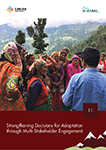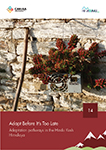Strengthening Decisions for Adaptation through Multi-Stakeholder Engagement
HI-AWARE Brief - 11
Key Message: Actors and contexts drive adaptation choices. HI-AWARE has used multi-stakeholder processes to prioritise context specific adaptation options, allowing for holistic planning around persistent risks in study basins of the Hindu Kush Himalayan (HKH) region. These prioritised options include, among others, water storage, high efficiency irrigation systems (HEIS), mixed cropping, preservation of local seeds (seed banking) and knowledge on local techniques for cardamom cultivation, and early-warning systems, in the Indus, Gandaki, Lower Teesta, Upper Teesta, and Upper Ganga river basins respectively.
Climate Smart Water Management Vital for Sustainable Agriculture in South Asia
HI-AWARE Brief - 12
Key Message: Climate smart water management practices are important to cope with increasing climate variability and improve agricultural sustainability in South Asia.
Novel solutions like solar powered irrigation pumps can accelerate the adoption of improved irrigation methods (e.g. drip or sprinkler) and proven water saving practices (e.g. mulching), and crop diversification.
In high- and mid-altitude mountains, re-adoption of traditional crops is vital to cope with water stress induced by rapidly changing patterns of snowfall and glacier melt.
Communities in the Indus, Ganges and Brahmaputra Basins Already Experiencing Critical Climate Stress Moments
HI-AWARE Brief - 13
Key Message: Communities in the Hindu Kush Himalayan region are already experiencing critical climate stress moments, which form a growing risk to their livelihoods. These stresses are experienced differently by men and women and are driven by a changing climate and perceptions of more extreme weather events in the past years. Community perceptions of change and climate events in the past ten years reveal increasing temperatures, erratic and untimely rainfall, hailstorms, drought and decrease in snowfall. These variabilities affect agriculture, the major component of their livelihoods, at various stages of the crop cycle depending on the study sites, and communities are adapting to these changes by altering the crop cycle or shifting to climate resilient crops.
Adapt Before It’s Too Late: Adaptation pathways in the Hindu Kush Himalaya
HI-AWARE Brief - 14
Key Message: Adaptation requires careful consideration of what to do when in order to sustain development efforts over time.
Assessment of when people are most vulnerable guides adaptation to offer fit-for-purpose solutions to people in different socio-cultural contexts. Critical climate stress moments are already experienced across different sectors in the Hindu Kush Himalaya. People are coping, yet not prepared enough for future changes in climate. For timely adaptation it is crucial to assess when turning points for decision-making are reached.
HI-AWARE started the development of adaptation pathways in the Hindu Kush Himalaya region. Making adaptation pathways helps to assess whether development is sustainable within the context of climate change and when adaptations are needed. In order for development plans to be climate-resilient they need to include choices and actions that reduce climate change impacts to sustain development efforts over time. Participatory development of adaptation pathways helps to prepare for change and facilitate the transformation needed for adaptation.
Working Towards Effective Adaptation: Contributions from HI-AWARE pilots to enhancing climate resilience in the HKH region
HI-AWARE Brief - 15
Key Message: The pilots implemented by HI-AWARE present contextually relevant and ecologically friendly technologies in the field of flood resilience, climate smart agriculture, and water and heat stress management. They have shown promising results and responses to existing climate risks at the local level, and in preparation for uncertainties relating to future climate risks.
The co-designing, planning, testing and implementation of various technologies with communities and other stakeholders, and existing technologies, are critical factors for successful pilots in the HKH region.
- 1
- 2





